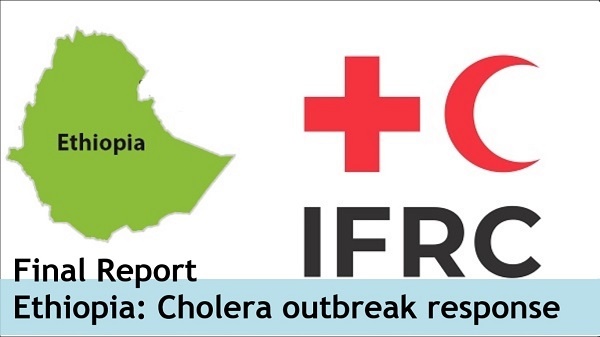
Ethiopia has a low sanitation coverage and has been frequently affected by Acute Watery Diarrhea and Cholera outbreaks. People have poor access to safe drinking water and sanitation facilities, and the situation is worse for those in rural areas – a final report of the International Federation of Red Cross and Red Crescent Societies (IFRC) on Ethiopia’s cholera outbreak response
A. SITUATION ANALYSIS
1 Description of the disaster
According to the WHO Weekly Bulletin on cholera outbreaks and other emergencies issued on 18 August 2019, from 12 April to 11 August 2019, 1,005 cholera cases, 37 confirmed and 18 associated deaths (cholera case facility rate: 1.00%) had been reported from five regions and two city administrative in Ethiopia. The affected administrative towns and regions were Oromia (437 cases, 43.5 %), Amhara (202 cases, 20%), Afar (164 cases and 1 death, 16%), Addis Ababa (146 cases, 14.5%), Diredawa (1 case.0.001%), Somali (33 cases, 3%) and Tigray (22 cases, 2%). In the capital, Addis Ababa the main affected sub-cities were Akaky-Kaliti and Addis Katema, which account for more than 50% of the cases reported in the town. By 11 August 2019, the total number of deaths recorded was 18. Of these cases, 13 were confirmed by culture of the stool specimen to identify vibrio cholera serogroup presence (5 in Oromia, 4 in Addis Ababa, 2 in Amhara and 2 in Tigray). The main identified risk factor is said to be the contaminated water sources. Prior to this report from WHO, Ethiopian Public Health Institute (EPHI) confirmed that there was cholera outbreak in Oromia, Amhara, Somali and Tigray and other cases were reported in Addis Ababa on 4 June 2019.
Ethiopia has a low sanitation coverage and has been frequently affected by Acute Watery Diarrhea and Cholera outbreaks. In Ethiopia, the general population have poor access to safe drinking water and sanitation n facilities, and the situation is worse for those in rural areas. The national sanitation coverage in Ethiopia is only 57% which translates to more than 45 million people without access to improved sanitation facilities. Health service records and community-based surveys indicate that diarrheal diseases are major causes of morbidity and mortality in Ethiopia because of low access to safe water and adequate sanitation.
As part of the cholera outbreak response, the Ethiopian health authorities set up 13 Cholera Treatment Centers (CTC) across the affected regions and deployed 847 health professionals in the affected regions to support the operation. To control the outbreak, the following activities were implemented by the government with allocated budget of ETB 134.2 Million: surveillance, early case detection, case management, prepositioning medical supplies and laboratory equipment’s at the strategic warehouse.
To support Government action, Ethiopian Red Cross Society (ERCS), with support from IFRC, launched a DREF operation for CHF 338,886 to reduce the morbidity and mortality due to the Cholera outbreak in the affected zones of Amhara and Oromia and sub-cities in Addis Ababa, through implementation of social mobilization and awareness creation activities targeting an overall 350,000 people or 70,000 households.
Download the full report by clicking here: DREF Operation Final Report
Source: IFRC
